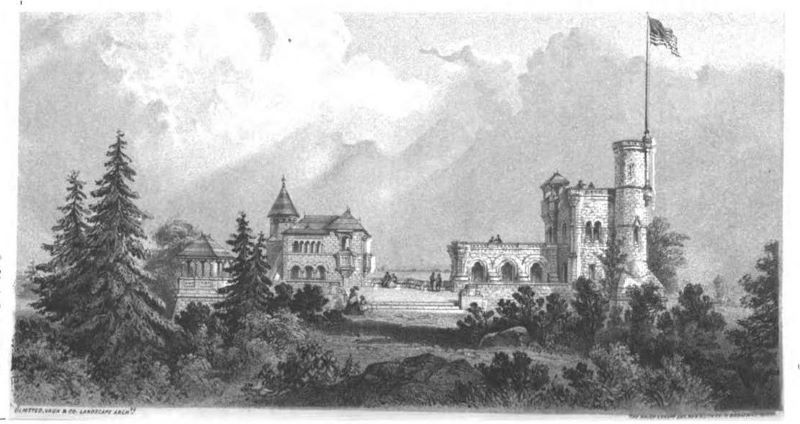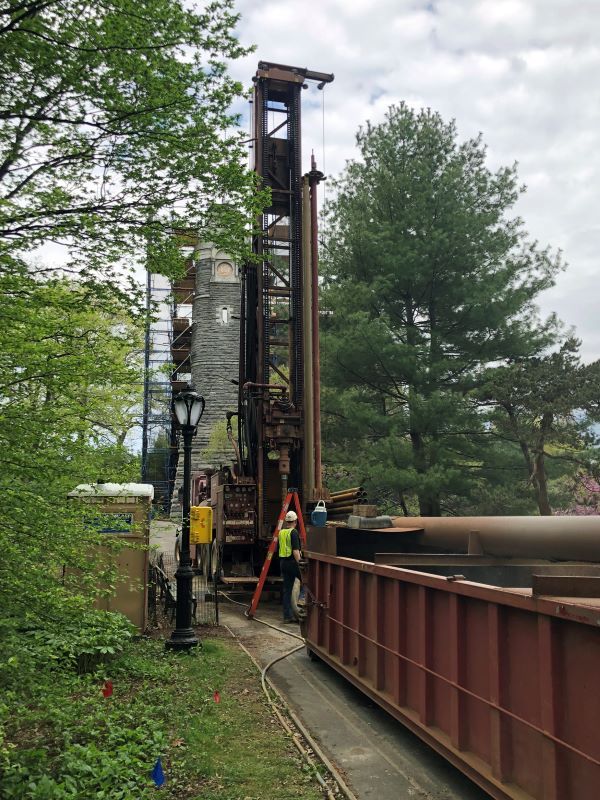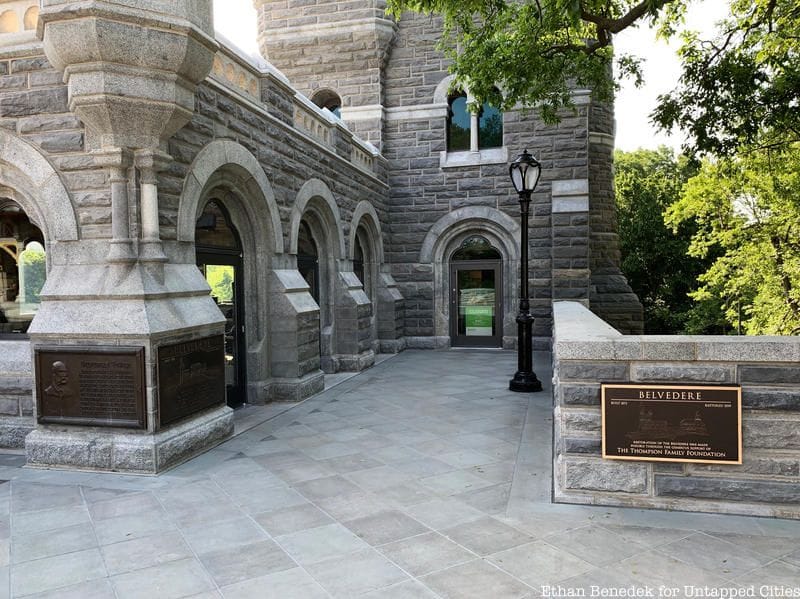NYC’s Forgotten ‘War on Christmas Trees’
Discover how an obscure holiday crackdown affects festive street vendors today!

Following more than a year of extensive renovations, Central Park's beloved Belvedere Castle is open to the public NYC!

The historic Belvedere Castle in New York City’s Central Park reopened to the public in June 2019, marking the end of the Central Park Conservancy‘s fifteen-month-long, $12 million restoration of the iconic site. Since its opening in 1872, the Belvedere has held its place among New York’s architectural beauties, drawing visitors for both its historical value and gorgeous views from the park’s second-highest point. With a fitting name which means “beautiful view” in Italian, it’s no wonder the site draws a million visitors every year. In honor of the castle in the heart of the big city, here is a list of ten little-known facts:

The Belvedere’s designers conceived of it as a “folly,” a building with no purpose other than its aesthetic appeal. It was built over the top of an older bell tower that had served a functional use for the nearby reservoir. Perhaps its purpose of getting its predecessor out of the way was important–the bell tower was so ugly that Clarence Cook, an important art critic at the time for the New York Herald Tribune, called the original structure an “eye-sore” in his column. When the more elaborate and fairytale-like castle replaced the tower, its view was called a “panorama,” and the castle became another incredible architectural transformation in New York.
Belvedere Castle was constructed using Manhattan schist, a naturally occurring rock that is responsible for much of the natural geography of Manhattan and is the same type that makes up Vista Rock – the castle’s base. This is why the castle appears to be emerging straight from its rocky foundation. The light-colored trim is made from granite quarried in Massachusetts.

Belvedere Castle has a long history of being an instrument for meteorological study. In 1919, the U.S. Weather Service moved into Belvedere after being forced to move from the Central Park Arsenal when plans were put in place to demolish that structure. The modifications made by the U.S. Weather Service to the castle created the biggest change the building had experienced since its construction in 1827. In order to equip the structure to collect weather data, the windows and doors were sealed off and the tower in the middle was removed and replaced with an antenna. It was the first time that the building had functioned as anything other than Olmsted and Vaux’s original intention of a beautiful, decorative structure. Unfortunately, the Weather Service’s move caused the castle to close to visitors. The public was barred from the castle until the 1980s.
The Weather Service also built another temperature measuring station on Vista Rock in 1922 just 100 feet from the castle. The construction was met with immediate outrage from locals because it marred the beautiful view of the Belvedere. Protests broke out and public letters to the Bureau called the new structure a “pig-sty” and an “illegal invasion.” Just a week later, the Weather Service relented and took it down, moving it to a less visible area. The weather service eventually automated its systems in the 1960s and the castle became completely abandoned.
Data, including New York City’s official temperature, continues to be collected from Belvedere Castle. In addition to the Weather Service making use of its strategic location, the National Oceanic and Atmospheric Administration (NOAA) has collected data on temperature, humidity, and precipitation from this site for over 50 years.

When Central Park Conservancy was founded in 1980, restoring the Belvedere was its first priority. During the 1960s and 1970s, the castle suffered severe neglect, becoming a victim of vandalism and rapid deterioration. Thanks to countless donations from organizations, foundations, and philanthropists, the first large-scale renovation commenced in 1983. The tower and pavilions were rebuilt, metal bars were removed, and wooden shutters were added.
While the castle had transformed into a visitors' center and gift shop, the problems were not all solved. Continued issues with drainage, waterproofing, and climate control meant Belvedere’s construction would continue to deteriorate for the next thirty years. The renovation marked a major step in bringing the Belvedere to its current state, but by the 2010s, another renovation of the core of the castle’s foundation was also necessary.

150 years ago, Belvedere Castle had an additional decorative wooden tower sticking out of its Northwest Pavilion. Renovators were committed to not only fortifying the existing structure but also trying to bring its new look as close to the original structure built as possible. To accomplish this, an entirely new structure from the historic Belvedere was recreated. In original plans created by Olmsted and Vaux, this northwest corner was home to a second stone tower, but that tower was never built. Instead, when the castle was constructed the northwest corner was home to a decorative wooden tower designed by Jacob Wrey Mould, an architect who worked under Calvert Vaux on many of Central Park’s buildings. Unfortunately, due to structural issues, the tower was torn down in 1872.
Today the wooden tower once again stands opposite the iconic stone tower we have come to know and love. The wooden tower is a tribute to the original architects’ vision of the castle as a “picturesque” structure and now adds balance to the architecture as you gaze up from below.

Believe it or not, the lush green of Central Park’s Great Lawn was once a large body of water, the Croton Reservoir, which was supplied by the Old Croton Aqueduct System that ran to the city up until the 1930s. Belvedere designers Olmsted and Vaux were not fans of the reservoir’s aesthetic. They thought it was too large and marred the natural curvatures of the park. So, they tried to conceal the water from public view by planting large amounts of vegetation around the edges. The only place from which they were unable to hide it completely was Belvedere Castle, because of the structure’s point of elevation overlooking the park.
Although the reservoir has long since been covered over and the aqueduct system is gone, its traces can still be seen throughout the city, especially in Central Park. Many sections of wall protruding from the park’s greenery once contained the reservoir’s waters and walls can be seen inside and around the police station on 86th Street. While Bethesda Fountain, located next to Bethesda Park in the lower center of the park, draws large crowds on every beautiful day, few know that the fountain actually commemorates the Croton System. The angel on the fountain references the Gospel of John, in which a fountain develops healing powers when it is blessed by an angel. In the angel’s hand is a lily, representing the importance of the water’s purity.
Now, the view from Belvedere Castle is much changed. Visitors can see the Great Lawn in the distance to the North, where the Reservoir once stood, and Turtle Pond, a beautiful body of water that would surely meet Olmsted and Vaux’s standards. To the South lies the Ramble, a naturalist area of small walking paths winding around tall trees. Its groves of trees and curved shapes harmonize closely with the original vision of the park.

The new renovations are ushering in a new phase for Belvedere and sustainability was an important factor. That’s why a new zero emissions, geothermal heating and cooling system was installed in the castle. The new additions will also solve many of the problems with leakage that first caused the structure’s deterioration.
To keep the mechanics concealed from visitors, workers had to construct the system 400-feet deep inside Vista Rock, where the ground remains 50-60 degrees. The system will move water into the earth below the rock, where it’s either heated or cooled and then pumped back up to the castle. The air then filters in through a heat exchanger. Because the whole process happens so far under the ground, it won’t interfere with the appearance of the castle for visitors.

While the views looking out from the windows and viewing platforms are stunning, the views looking up at it are just as important. Over the fifteen-month renovation, the castle was obscured by netting and scaffolding as crews worked on bringing the castle back to its former glory.
On a summer night, Belvedere is already a beautiful silhouette against the evening sky. To enhance the view looking up from Turtle Pond, construction crews have set up lights all around the castle so that it will be illuminated at night. On your next evening stroll through the Park, stop by Turtle Pond to see the already breathtaking view of the Castle from the water brightly enhanced. The lights will sparkle on the water of the pond and will draw all eyes to this architectural achievement.

Co-designers Frederick Law Olmsted and Calvert Vaux’s original idea was for the Castle to be an open-air lookout tower, an optimal point from which visitors could take in views of the park. While Olmsted and Vaux’s original plans were disregarded with the construction of windows and doors throughout the castle, the new renovations hold true to Olmsted and Vaux’s desire for the castle to be a lookout. Clear pane glass has been installed in all existing windows and doors so that visitors can easily see out of the openings. From a distance, you won’t even be able to tell that there is glass in the openings.
The renovations have also solidified the original foundations of the Belvedere. The walls surrounding the terraces have been taken apart and reconstructed, and stonework both inside and outside that has built up dirt over the years has been cleaned and repaired. The terrace itself now has a new look with a checkered stone design inspired by the original plan.

While the re-opening of Belvedere marks a major accomplishment for the Central Park Conservancy, renovations of the area are not completely done just yet. The Conservancy wants all visitors to be able to enjoy the re-opened castle, so work is being done on another round of renovations that will make the castle accessible for wheelchairs. The new route will reconstruct a path running between Belvedere and East Drive.
For now, Belvedere Castle will be accessible by foot upon its reopening. You can reach the castle from the 81st Street entrance on the Westside, near the Natural History Museum. From there on, take the 79th Street Transverse past the Shakespeare Gardens. The Castle is just south of Turtle Pond.

Belvedere Castle is not only a beautiful site to look at, but also a venue for talks, performances, community get-togethers, family programs, and more. With the new opening, it will once again become an important part of the New York community. To think, Belvedere Castle itself was not even in the original Greensward Plan developed for the park.
The Castle has already served as the base for a range of different city events, like a New Year’s Eve bike ride starting in Washington Square Park and ending at the high point of the Castle, an interactive lecture on New York City’s wildlife, and a scavenger hunt held by the Museum of the City of New York. With its reopening, the Castle can once again take its place as a cultural hub in the midst of the park.
Next, check out 10 Historic Ruins and Remnants Inside NYC’s Central Park
Subscribe to our newsletter